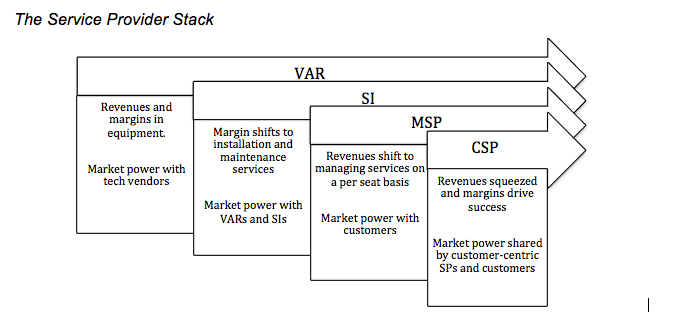You may find yourself one of the thousands of service providers asking “How do successful companies deal with survival and growth in a dynamic and changing industry?” Wherever you are in the service provider stack you must face whether to innovate, adding new technologies and business models to ensure long-term competitiveness and catalyze growth. I recently hosted an industry panel of successful service provider leaders. The five insights in this post offer advice to service providers considering building a cloud practice.
When I finished school in 1994 my first job was at Fujitsu, the large Japanese tech conglomerate. In my stint as a product manager and later in international marketing I was exposed to Fujitsu’s channel business. Back then the notion of MSPs didn’t exist. Instead, most channel intermediaries were VARs (value added resellers) re-selling manufacturer hardware. Later when I moved to Tekelec into an internal channel development role, I observed a market shift. As VAR competition increased, hardware margins shrunk for all, and VARs transitioned to become system integrators(SIs), selling equipment and software along with implementation and support services. The next transition occurred when market competition again saturated driving down SI margins. This forced their business model to bundle managed IT services — equipment, software, installation, services and support all charged on a per seat basis — to their clients. Thus the MSP was born. More recently technology ubiquity is driving a notable shift of MSPs to become cloud service providers (CSPs).

Contemplating this evolution (or devolution, depending how big your equipment margins once were), clearly one of the most difficult challenges for service provider leaders is grappling with whether to change the company’s core business offerings in an effort to sustain, let alone grow, the business. It’s a classic case of the innovator’s dilemma.
Insight #1: Realize that change is uncomfortable. Jason Waldrop, CEO of CWPS in Washington D.C., shared, “You can do the right thing for too long. As cloud starts to emerge things get uncomfortable. We used to go to the legacy vendor shows and they would announce a new offering and it would align exactly with what our customers wanted. Now it’s different; now we have to retool our [own] portfolio with the emergence of the cloud and cloud products.”
Insight #2: Deploy new offerings in a way that fits your business. Waldrop offered, “As it relates to cloud [the question is whether to] build, buy, or partner? Cloud can create a hole in your balance sheet fast. There are some aspects that we chose to build like back up, but we chose to leverage vendors for other aspects. We stay close to our customers, let the vendors with the big balance sheets do the innovation and deal with the capital investment, then we are the intermediary between that world and our customers. There is a place to play there for a very long time.”
Insight #3: Be aware of good vs. bad margin business. Tommy Wald, formerly of White Glove Technologies in Austin, chimed in, “Today, being a generalist in the cloud is not where the good margin is. As [MSPs] move into the cloud the good revenue is in the areas where you have a specialty and you can charge a premium — because your customers believe you have some type of [specialized] business knowledge. For example, if you are trying to make money off of Microsoft 365 migrations, some companies are doing well by wrapping application development around it. But you can’t just resell 365, the margin is not good enough. There are opportunities out there — you just have to decide what you want to put your stake into.”
Insight #4: Manage cloud risk. Tim Britt, CEO of global service provider Synoptek added, “Your services portfolio is like your investment portfolio. You have some high risk, high reward items and some that send [an] annuity in everyday. You have to know which is which and not have too much high-risk or low margin services. Look at your services and how they compliment each other. Which are there so you can ‘defend your turf’? And which ones are there so you can be a leader in what you want to do? And make sure to have a clear strategy around each.”
Insight #5: It’s all about the customer. Ultimately the panelists agreed that growth and success today requires creating an organization dedicated to providing value to the customer each and every day. It’s the only way to stay relevant, competitive, allow for innovation and to fuel growth. Synoptek’s Britt summarized, “We found over the years that [customers] tells us when they are ready for a change. If we listen to our customers we know when it is the right time to make the move to the next thing.”
The power center of the IT services market has clearly shifted to the customer — and to those service providers paying most attention to their needs.
